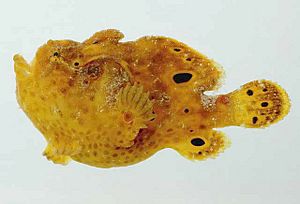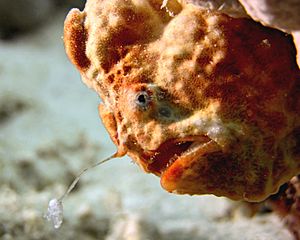Longlure frogfish facts for kids
Quick facts for kids Longlure frogfish |
|
|---|---|
 |
|
 |
|
| Conservation status | |
| Scientific classification | |
 |
The longlure frogfish (Antennarius multiocellatus) is a unique fish found in the western Atlantic. You can spot it from Bermuda and the Bahamas all the way down to Brazil. This amazing creature lives in warm, shallow coral reefs, especially where there are lots of sponges. It usually stays at depths less than 215 feet (66 meters).
Amazing Camouflage
The longlure frogfish is a master of disguise. It lives on the ocean floor and can change its skin color to match the sponges around it. This helps it blend in perfectly with its surroundings. It also has special eye-like spots, called ocellii, that look just like the openings in a sponge. This makes it almost impossible to see!
Instead of swimming, this frogfish slowly "walks" across the bottom. It uses its special stalked pectoral fins and pelvic fins like tiny legs. Sometimes, you might even see a frogfish puff itself up. It does this by filling its stomach with air or water. This fish usually lives alone and is harmless to humans. It is also the most common type of frogfish in the West Indies.
What Does It Look Like?
The longlure frogfish is a short, round, and somewhat fat fish. It usually grows to about 5 to 8 inches (13 to 20 cm) long. Its skin is thick and covered in prickly bumps called dermal spicules. These bumps make it look a bit like a toad.
This frogfish has small eyes and a very large mouth that points upwards. Its gill openings are tiny and located behind its pectoral fins. The color of a longlure frogfish can change a lot. It can be pale yellow, bright red, dark green, or even reddish-brown. No matter the main color, it always has black spots scattered across its body. The name multiocellatus actually means "many eye-like spots" in Latin. Some frogfish are completely black, except for white tips on their fins and a pale, saddle-like area on their back.
Reproduction
Frogfish have a very interesting way of laying eggs. The female releases her eggs in a floating mass of mucus, which is called an "egg raft." This raft helps carry a large number of eggs across long distances in the ocean.
Before spawning, the male and female frogfish "march" together across the seabed. The female leads, and the male stays very close behind her. During this time, the female is full of eggs and can swell to twice her normal size! Then, the pair quickly swims to the surface, and the egg mass bursts from the female. A female frogfish can lay eggs several times over a few weeks.
How It Hunts
The longlure frogfish is a fierce hunter that waits for its prey. It mainly eats other fish, but it also enjoys crabs and mantis shrimp. Its name, "longlure," comes from its amazing fishing rod! This "rod" is called an illicium. It's actually the first spine of its dorsal fin, which has changed into a long rod with a lure, called an esca, at the end.
The esca often looks like something tasty, such as a worm, a small crab, or even a tiny fish. The frogfish will hide in a sponge and wait. When a fish swims by, it wiggles its lure to attract the prey. Then, in a flash, it can swallow a fish even bigger than itself! If no fish are biting, the frogfish will move to a new spot, just like a human angler. The longlure frogfish is one of the fastest animals when it comes to catching prey. It can move and suck in its meal in as little as 0.006 seconds! You need a high-speed camera to even see it happen.
See also
 In Spanish: Pez rana para niños
In Spanish: Pez rana para niños


